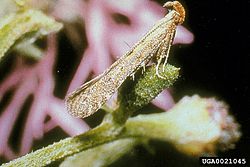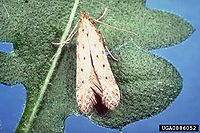- Metzneria paucipunctella
-
Metzneria paucipunctella 
Scientific classification Kingdom: Animalia Phylum: Arthropoda Class: Insecta Order: Lepidoptera Family: Gelechiidae Genus: Metzneria Species: M. paucipunctella Binomial name Metzneria paucipunctella
Zeller, 1839Synonyms - Metzneria luqueti Nel, 1995
Metzneria paucipunctella is a species of moth known as the spotted knapweed seed head moth. It is used as an agent of biological pest control against noxious knapweeds, particularly spotted knapweed (Centaurea maculosa).
The adult moth is narrow-bodied and about 8 millimeters long. It is brownish-gray and lightly speckled. It has large recurved antennae. The female lays about 80 eggs, depositing each at the base of a flower head. In about ten days the larva emerges and burrows into the flower head where it feeds on the developing seeds and florets. The larva is a small, plump white grub with a dark head and visible body segments. It overwinters inside the seed head and pupates the following spring.
This moth is native to Europe. It was first introduced as a biocontrol agent for knapweeds in the United States in 1980, and it is now established in much of the western United States. The larvae of this moth compete with other head-dwelling biocontrol agents; if they find the larvae of another species they attack and consume them. Nevertheless, knapweed control is better when the moth works in tandem with other insects.
References
- Coombs, E. M., et al., Eds. (2004). Biological Control of Invasive Plants in the United States. Corvallis: Oregon State University Press, 218.
External links

This article on a moth of the Gelechiidae family is a stub. You can help Wikipedia by expanding it.

